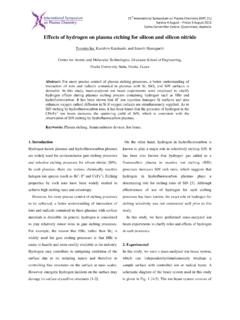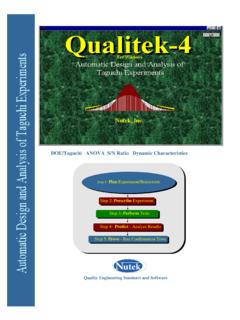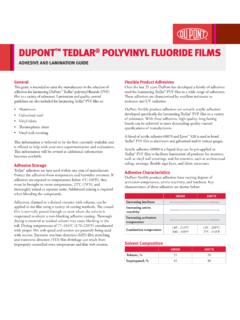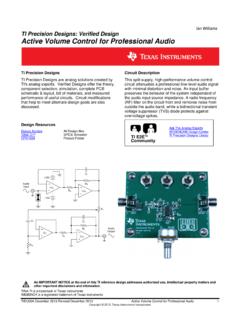Transcription of Nanostructured Ti thin films by combining GLAD and ...
1 22nd International Symposium on Plasma Chemistry July 5-10, 2015; Antwerp, Belgium O-18 -3 1 Nanostructured Ti thin films by combining GLAD and magnetron sputtering : a joint experimental and modeling study J. Dervaux1, Cormier1, S. Konstantinidis1, P. Moskovkin2, S. Lucas2 and R. Snyders1,3 1 Universi de Mons, Place du parc 20, BE-7000 Mons, Belgium 2 Universit de Namur, PMR-LARN, 61 rue de Bruxelles, BE-5000 Namur, Belgium 3 Materia-Nova, Avenue N. Copernic 1, BE-7000 Mons, Belgium Abstract: In this work magnetron sputter deposition and Glancing Angle Deposition are combined to synthesize Nanostructured Ti films . Different type of microstructures (tilted columns, straight pillars, chevrons, ..) can be obtained by varying the substrate orientation. In order to understand the mechanisms leading to the formation of each structure the NASCAM code was used to simulate the growth of the film.
2 We show that an advanced growth simulator like NASCAM enables quantitative prediction of numerous physical properties, including film density, surface roughness, and column shape asymmetry. The simulator can also be used to understand the effects of different process variables such as gas pressure and substrate rotation rates. Keywords: simulation, Ti thin film, GLAD, magnetron sputtering , Nanostructured 1. Introduction Nowadays, the efficient use of renewable energies represents a major economic and environmental issue. Obviously this statement also holds true for the solar energy, by far the most important of them in term of quantity. In this context, among the many advantages of the dye-sensitive solar cells (DSSC), their cheap production cost and good performance at low illumination and high temperatures are very appealing [1-5].
3 However, the photo-anode of a DSSC is often composed of an array of TiO2 nanoparticles. In this situation, the charge transport is limited by trapping-detrapping processes. So, even if these nanoporous TiO2 films have large surface areas (around 56 m2/g for P25 [6]) and allow an efficient collection of photons, the electron transport is a limiting factor for the conversion efficiency. Ideally, the porous film must have interconnected particles, to allow the percolation of the injected electrons [7]. A potential alternative would be a porous crystalline TiO2 thin film with nanoscale ordered photo-anode architectures, such as nanotubes [7], nanorods [8] and nanowires [9]. The main potential advantage of these structures relies on a better collection of charges as they provide a straightforward path towards the external circuit so that recombination at the grain boundaries and exposure to the electron acceptors in the electrolyte are avoided.
4 In this way, faster transport and a slower recombination rate lead to a minimization of charge losses. In order to generate such a porous coating, we combined magnetron sputtering (MS) and GLancing Angle Deposition (GLAD). To understand the growth mechanisms, the synthesis of titanium coatings are used as a model system. In this work, the NASCAM (NAnoSCAle Modeling) code was used to simulate the growth of the film in order to gain understanding on the fundamental mechanisms involved into the growth process [10]. 2. Materials and Methods Experiment magnetron sputter deposition process allows a good control of the film density, adhesion, surface roughness, and crystallinity and it is also cost effective for industrial applications, overcoming the current barriers in other film deposition processes [12].
5 In the present study, all experiments were carried out in a cylindrical stainless steel chamber (height: 60 cm, diameter: 42 cm). The later was evacuated by a turbo-molecular pump (Edwards nEXT400D 160W), backed by a dry primary pump, down to a residual pressure of 10-5 Pa. An unbalanced magnetron cathode was installed at the top of the chamber. The substrate was installed at a distance of 80 mm (Fig. 1). A 2-inch in diameter and thick Ti target ( % purity) was used. The target was sputtered in DC mode in an argon atmosphere (12 sccm) [12]. Ballistic shadowing is the foundation of GLAD-based thin film engineering. Such shadowing is only possible if the incoming vapor flux is well collimated. In this method, the substrate can be tilted with an angle ( = 85 in this work) and/or rotated with an angle ( ) step by step or with a continuous angular speed ( s) in order to generate a columnar porous thin film (Fig.)
6 1). The GLAD process enables the growth of columnar thin films with specially engineered nanostructures. These films are extremely porous (100 m /g for TiO2 [13]) and consist of isolated columns that can take the morphology of, for example, helices, vertical posts and helicoidally structure [14]. The porosity (inter-columnar space) and the columnar tilt 2 O-18 -3 a) b) 56 12 angle ( ) can be tuned to have open pores (mesopores) to increase the specific surface area and improve the dye and electrolyte penetration in the case of specific DSSC applications [15, 16]. The morphology was characterized with a field emission gun scanning electron microscope (FEG-SEM Hitachi SU8020). To compare the apparent specific surface area of thin films , we define the aspect ratio parameter which is calculated by dividing the inter-columnar space by the width of the columns.
7 The films thickness was kept constant at 175 20 nm for the films grown without any modification of the angle and 350 20 nm for the films which were grown under a controlled rotation speed. The thickness was measured by a Dektak 150 profilometer and the deposition times are 20 and 40 min, respectively, with a calculated deposition rate of nm/min. Fig. 1. Experimental setup of the deposition chamber [12]. Simulation tool NASCAM (NAnoSCAle Modeling) is an atomistic deposition simulation code based on the Kinetic Monte Carlo (kMC) method. It can be used for the modeling of different processes occurring at the surface such as growth of films during deposition, post deposited development of films ( , annealing or ion bombardment), .. The atoms are deposited on the substrate at random positions at an equal time interval which is determined by the deposition rate.
8 Only diffusion or evaporation events can take place between two deposition events. Energy transfer during ballistic collision events is also taken into account. A particular feature of NASCAM is that the substrate can be animated of movements like translation, rotation or oscillation. That makes it suitable to simulate Glancing Angle Deposition processes. [17] In this work, no diffusion was taken into account. The energy and angular distribution of incident particles were calculated by SRIM [17] and SIMTRA [19]. First, SRIM is used to calculate the energy and the direction of particles which leave the target. The particles are then transported in the gas phase by the SIMTRA code which takes into account all the collisions between the sputtered species and the gas molecules. The energy and the angular distribution of the species at the substrate location are derived for each working conditions by the introduction of the experimental parameters as the working pressure, the particles energy which is function of the power applied at the target, the racetrack sizes, the target-substrate distance.
9 After that, these files will be used as input data for NASCAM. Other parameter can be tuned in the input file. To can compare the simulation with the experience, we tune the number of deposited atoms ( ) and the substrate size (XYZ). In these conditions, the simulated and the experimental thin film had the same thickness. The deposition rate was fixed at monolayer by second which is close to the experimental value. 3. Results As the working pressure was varied, the sputtering power was adjusted in order to reach a constant deposition rate. A low pressure induces a large columnar tilt ( = 56 ) and conversely, a high pressure induces a low columnar tilt ( = 12 ). The corresponding simulations show the same behaviors (Fig. 2). The angle value of the column tilt angles are very close with 54 and 12 for the pressures of 1 and 10 mTorr, respectively.
10 The aspect ratio values for the 1 mTorr condition are and , for the simulation and the experiment, respectively. At a higher pressure, 10 mTorr, the aspect ratio decreases dramatically to , which is representative of a low specific surface area, for both experiment and simulation (Table. 1). Fig. 2. Simulation and cross sectional SEM observation of the Ti thin films synthesized at a) 1 mTorr, 150 W, and b) 10 mTorr, 110 W. O-18 -3 3 b) a) Table. 1. Comparison between experiment and simulation for film morphologies obtained in various conditions. Conditions Columnar tilt Aspect ratio Experiment Simulation Experiment Simulation 1 mTorr 150 W 56 54 2 mTorr 140 W 45 47 5 mTorr 120 W 28 15 10 mTorr 110 W 12 15 These observations can be explained by an increase of the pressure which leads to a decrease of the mean free path and an increase of the collision probability between particles.







